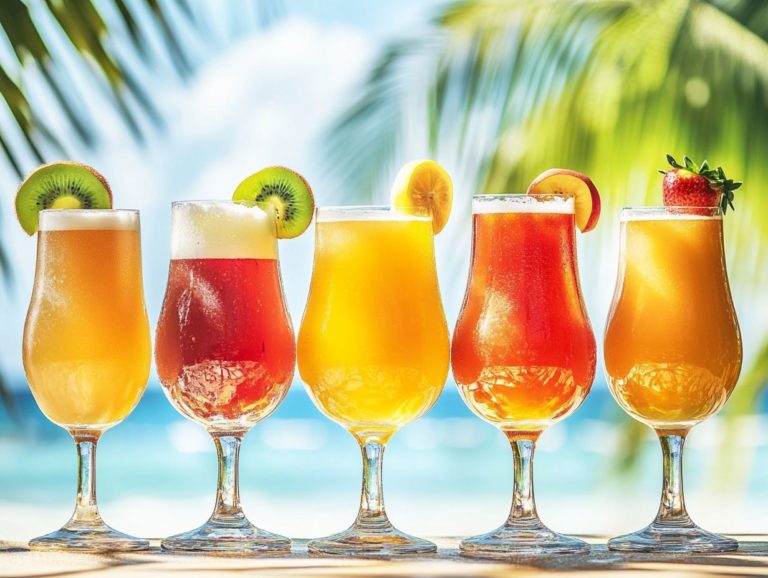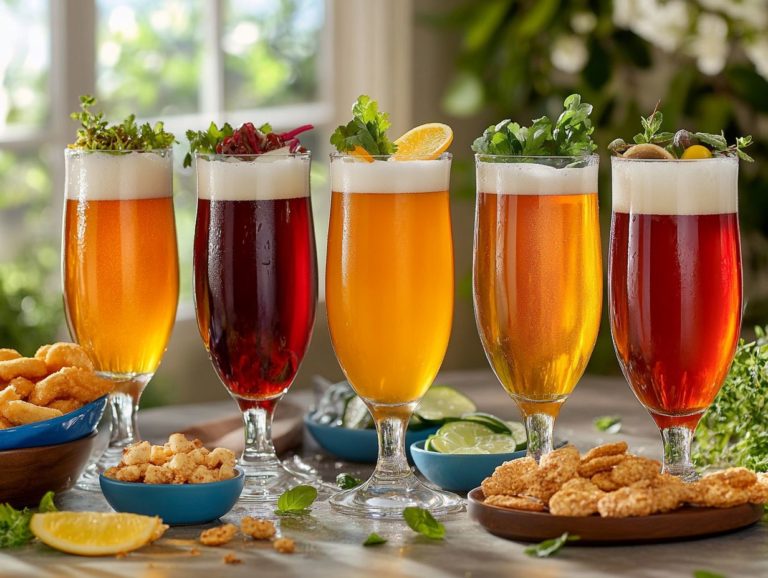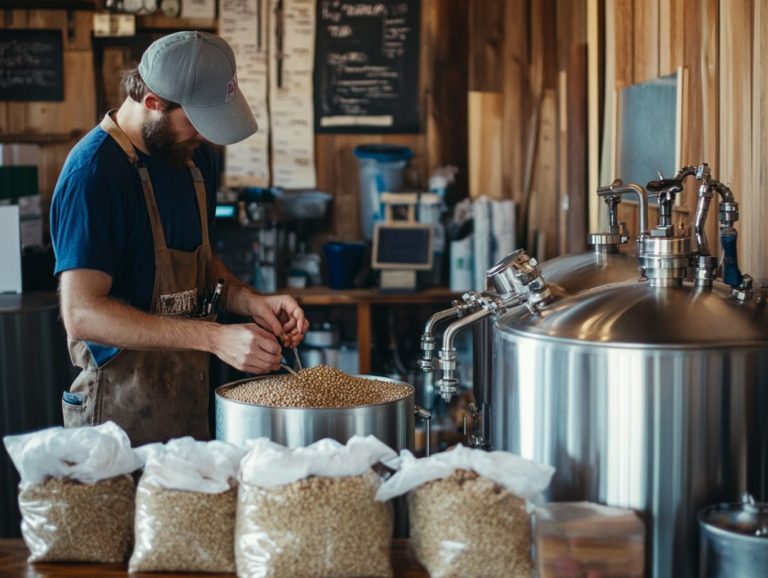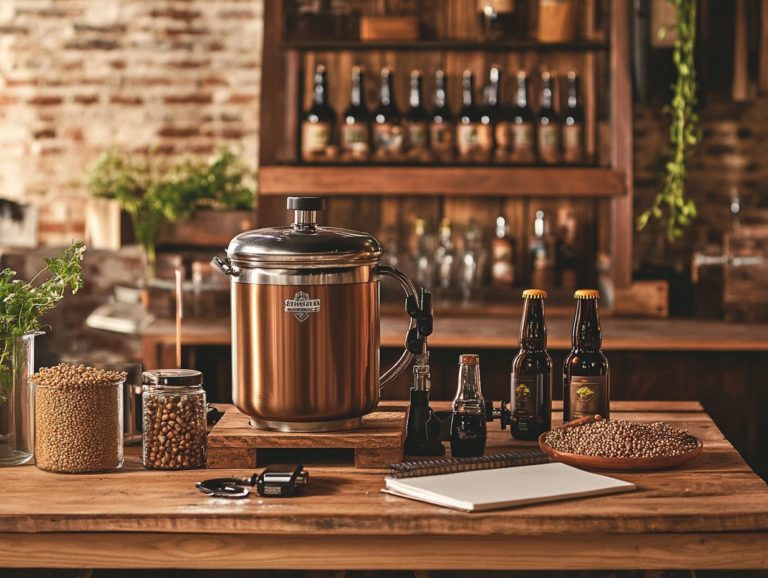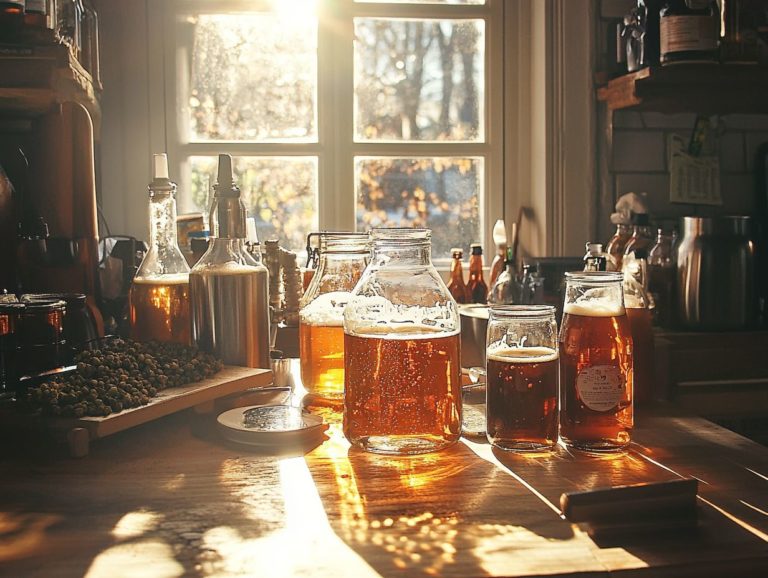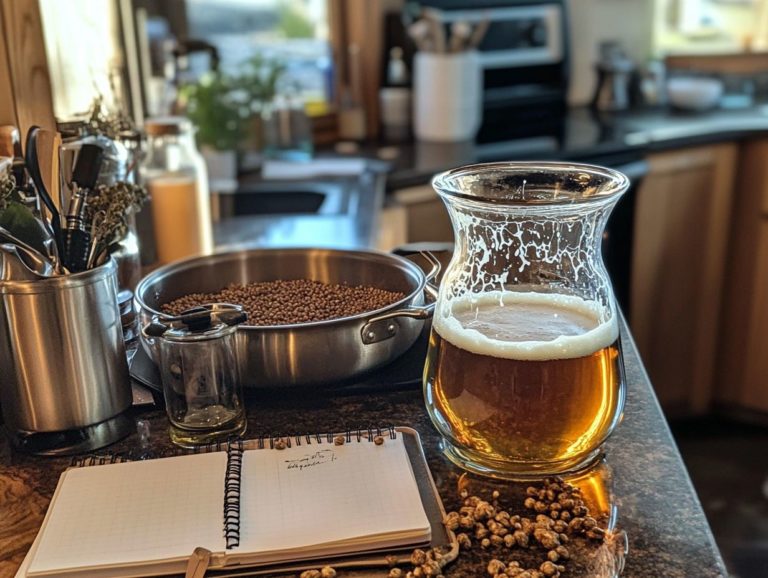How to Brew Your Favorite Beer at Home
Brewing your own beer at home is an exhilarating and fulfilling hobby that invites you to explore flavors and create distinctive brews tailored precisely to your palate. Much like experimenting with handmade pastas at an Italian restaurant, you ll be amazed at the endless possibilities of ingredients in beer brewing.
Uncover everything essential to embark on this journey. From the must-have brewing equipment and ingredients to the comprehensive step-by-step brewing process, this guide is like a detailed cooking class.
You ll discover invaluable tips for success, learn to sidestep common pitfalls, and gain access to resources that will support you throughout your brewing adventure.
Whether you re just starting out or aiming to elevate your skills, this guide will expertly lead you toward crafting your favorite beer right in your own kitchen, mimicking the precision needed to brew beer in a professional setting.
- Key Takeaways:
- What You Need to Get Started
- The Brewing Process
- Tips for Successful Home Brewing
- Common Mistakes to Avoid
- 1. Not Sanitizing Properly
- 2. Over or Under Carbonation
- Resources for Home Brewing
- Frequently Asked Questions
- Do I need to follow a specific recipe for home brewing?
- How long does it take to brew my favorite beer at home?
- Can I store my homebrew for later consumption?
- Invest in quality brewing equipment and ingredients before getting started, as they are crucial for producing excellent beer recipes.
- Sanitization is key to successful home brewing. Keep everything clean and sanitized to prevent contamination during the fermentation process.
- Don’t be afraid to experiment with different ingredients to customize your favorite beer at home.
Contents
Key Takeaways:
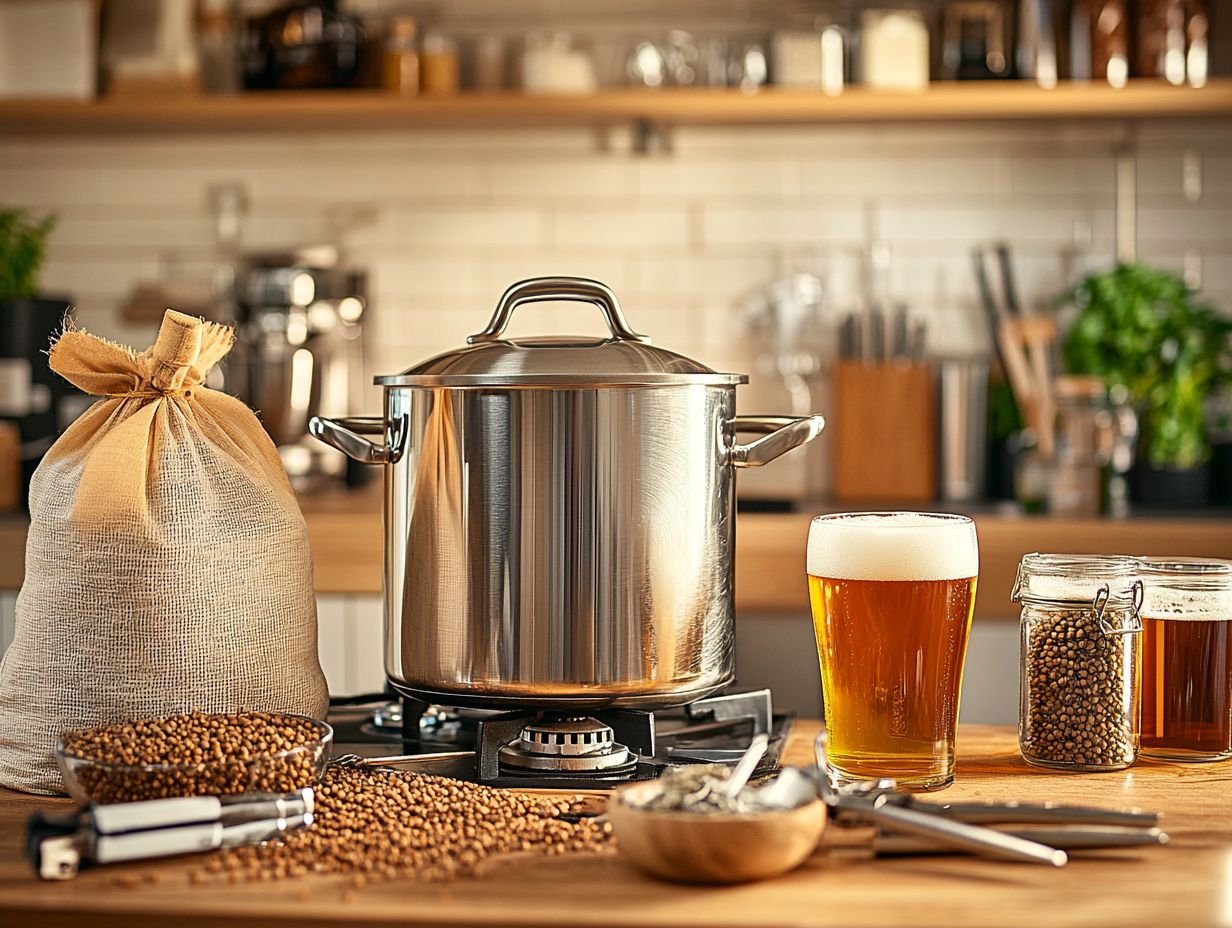
What You Need to Get Started
As you embark on your home brewing journey and delve into the fascinating world of beer making, it’s crucial to equip yourself with the right tools and ingredients tailored to your specific needs. Just as you would in a professional brewing community, familiarizing yourself with the various types of brewing equipment is essential.
Explore the different types of brewing equipment, such as fermenters and brewing kettles. Make sure to source high-quality ingredients like malt, hops, and yeast.
Whether your goal is to craft distinctive brews with countless variations or to enjoy a cooking class centered around brew day, having the proper setup will set the stage for a rewarding and successful brewing experience. Try exploring the history and techniques used by craft brewers to enhance your skills.
1. Brewing Equipment
The brewing equipment you need for successful home brewing includes some essential tools that are vital to the process. A brewing kettle is a must-have for boiling the wort, while the fermenter is where the fermentation process occurs. An airlock becomes your best friend, helping to create the perfect environment by allowing gases to escape while keeping contaminants at bay.
You should also expand your toolkit with a thermometer, hydrometer, and sanitizer. Precision in temperature and cleanliness is crucial for producing a stellar batch. Maintaining the right temperature ensures that the yeast performs at its best. A hydrometer is a tool that measures the sugar content in your wort, helping you determine its alcohol content. The use of essential oils in the brewing process can also add unique flavors to your beer.
In terms of sourcing quality brewing kits, look no further than specialty brewing supply stores or reputable online retailers. You’ll discover a variety of comprehensive brewing packages that cater to any experience level, paving the way for an enjoyable and fruitful brewing adventure. Brands like Northern Brewer and AHA offer excellent resources.
Now that you have the knowledge and tools, why not start brewing today? Share your experiences on social media and join the vibrant community of home brewers!
Ingredients
The foundation of any exceptional beer lies in its ingredients, which typically include malt, hops, and yeast. Each component plays a pivotal role in shaping the final product’s unique flavors and characteristics.
Quality malt supplies the essential sugars for fermentation. Meanwhile, hops introduce bitterness and aromatic qualities. Yeast performs the vital task of transforming those sugars into alcohol during fermentation.
By diving into the various types of malt available, such as pale, caramel, and chocolate malts, you enable yourself to create an impressive array of flavor profiles. These can range from light and crisp to rich and robust.
Hops, in their many forms whole cone, pellets, or extracts do more than just add bitterness. They also contribute delightful aromas that elevate the beer’s fragrance.
As a skilled brewer, you’ll recognize the importance of selecting the right yeast strain. Each type can bring forth distinct esters and phenols, enhancing or even transforming the overall taste experience.
These ingredients come together in perfect harmony, allowing you to craft a well-balanced beer that showcases your artistry and expertise in every single sip. Consider taking a practice tasting to become a certified beer judge to refine your palate.
The Brewing Process
Embark on a captivating journey as the brewing process transforms simple ingredients into extraordinary beer through several pivotal stages: mashing, boiling, fermentation, and finally, bottling and carbonation. Exploring the brewing history can provide a deeper understanding of each step.
Each stage requires its own techniques and practices. You’ll begin by meticulously controlling the mash temperature to achieve optimal sugar extraction. Then, move on to boiling the wort with hops that impart unique flavors.
As fermentation takes place, yeast performs its remarkable transformation. This ultimately leads to the creation of a tantalizing, drinkable beer.
Sanitizing Equipment
Sanitizing your equipment is an essential step in the home brewing process. It ensures your beer remains untouched by unwanted bacteria and contamination, preserving the integrity of your hard work.
It s imperative to use appropriate sanitizers like PBW and Star San to thoroughly clean all your brewing equipment. This includes fermenters and brewing kettles before each brew day.
Utilizing effective sanitizing agents not only protects the quality of your brew but also fosters a seamless fermentation process. These agents, paired with practices such as soaking your equipment for the recommended time, contribute significantly to optimal sanitation.
Don’t forget to rinse your equipment with hot water after using PBW to remove any residue. On the flip side, Star San doesn’t require rinsing, making it a wonderfully convenient option for quick sanitization.
Consistency in these sanitation practices is the key to achieving that perfect pint. Even the slightest oversight can result in off-flavors in your finished product.
Mashing
Mashing is the process where you take crushed grains and mix them with hot water in a mash tun. This allows natural catalysts to work their magic by converting starches into fermentable sugars.
This step lays the foundation for your beer’s profile and demands your careful attention to both water temperature and the water-to-malt ratio. This ensures optimal sugar extraction and flavor development.
During this phase, you’ll be using various types of grains, including barley, wheat, and rye. Each grain imparts its own unique flavors and characteristics to the final brew.
Temperature control is crucial; typically, keeping it between 148 F and 158 F allows the enzymes especially amylase to efficiently break down those starches. This enzymatic action not only boosts sugar production but also influences the mouthfeel and body of the beer.
Grasping these dynamics in the mashing process is essential. This knowledge helps any brewer craft distinctive and high-quality beverages.
3. Boiling
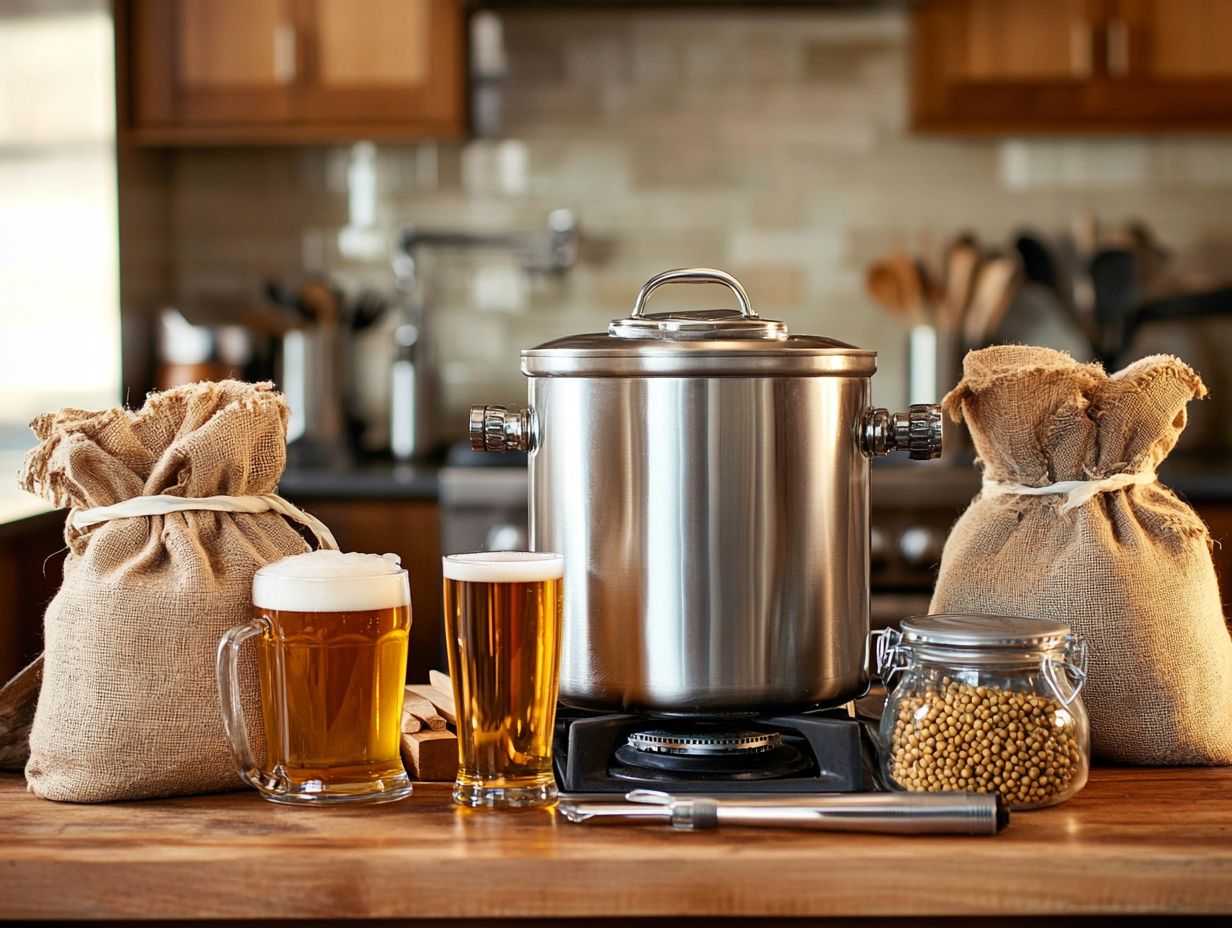
The boiling stage is an important point in your brewing journey, taking place in the brew kettle where you heat the wort to a rolling boil. This is when the magic happens flavors from the hops are extracted, and any unwanted compounds are eliminated. This step typically lasts for a predetermined duration, allowing you to make hop additions that will define the bitterness and aroma of your finished beer. Pour cooled wort carefully to prevent oxidation.
At this essential stage, the timing of your hop additions is paramount in shaping the beer’s final profile. Early hop additions contribute to the bitterness, creating a balance against the sweetness of the malt. Later additions enhance the aromatic qualities, introducing floral, fruity, or spicy notes that the brewing community loves to celebrate.
By mastering this timing, you can elevate a simple brew into a complex masterpiece. This influences not just the taste but also the overall experience of savoring a well-crafted beer. Understanding these nuances enables you to create unique profiles that resonate with those who truly appreciate the artistry behind brewing.
4. Fermentation
Fermentation is the exciting phase in the brewing process where yeast works its magic, transforming sugars from the wort into alcohol and carbon dioxide, ultimately shaping the unique character of your beer. It s essential to control the fermentation temperature during this stage, as it directly influences flavor profiles and helps prevent off-flavors, ensuring you end up with a clean, delightful brew. Using a yeast starter can help ensure a vigorous fermentation process.
The choice of yeast you employ in brewing like Saccharomyces cerevisiae for ales and Saccharomyces pastorianus for lagers plays a pivotal role in crafting the beer’s aroma and taste. Yeast doesn t just generate alcohol; it also produces a variety of compounds, including esters and phenols, contributing those inviting fruity or spicy notes. To avoid unwanted flavors, such as fusel alcohols, aim for an optimal fermentation temperature of 65 F to 75 F for ales and 50 F to 55 F for lagers. Using bottled spring water can also enhance the purity and taste of your final product.
As the yeast ferments, its activity and the temperature interact to shape the final product, showcasing your expertise as a brewer in achieving the desired complexity and profile of the beer.
5. Bottling, Kegging, and Carbonation
Bottling, kegging, and carbonation mark the final steps in your brewing journey, where the fermented beer is transferred into bottles or kegs. You introduce additional sugars to kickstart carbonation. This critical phase not only seals the beer properly but also enhances its mouthfeel and overall enjoyment. Some brewers prefer kegging beer for better control over carbonation levels.
During this stage, you’ll likely employ techniques such as siphoning or using counter-pressure fillers to minimize oxygen exposure, which is essential for preserving the integrity of the beer’s flavor. Different types of sugars like corn sugar or malt extract are commonly used to promote carbonation. These fermentable sugars create carbon dioxide when consumed by the yeast, resulting in those delightful bubbles.
Sanitation is crucial; thoroughly clean all your equipment, including bottles and kegs. Any hint of contamination could spoil your entire batch. By paying close attention to these details, you not only enhance the final product but also elevate the experience for everyone who gets to enjoy it. Always remember to sanitize equipment properly.
Tips for Successful Home Brewing
Home brewing is an art that involves various brewing techniques to achieve the perfect beer.
For successful home brewing, it’s essential to embrace specific best practices that elevate your brewing experience and enhance the quality of your beer. The brewing community is always a great resource for tips and advice.
By adhering to proven beer recipes while also allowing room for experimentation, you open the door to discovering unique flavors and styles that truly resonate within the brewing community. Popular beer recipes often include a mix of different malts, hops, and yeasts to create diverse flavor profiles.
1. Follow Beer Recipes Carefully
Carefully follow beer recipes to achieve consistent results. Each ingredient plays a specific role in your final product.
By adhering to detailed instructions about malt types, hop additions, yeast starters, and fermentation practices, you can ensure that your beer turns out just as you envisioned.
This precision becomes even more crucial when you experiment with popular beer recipes, like IPAs or stouts, where variations in specific ingredients can dramatically influence flavor and aroma.
For example, an IPA recipe demands a unique combination of hops, which may impart delightful citrusy or piney notes. In contrast, a stout recipe relies heavily on dark malts to deliver its rich, roasted characteristics. Using unique hops can also add an extra layer of complexity to your brew.
Adapting these recipes requires careful consideration of ingredient quantities and brewing temperatures. Any deviation might lead to a product that strays from your desired style. Understanding the role of each component sharpens your brewing skills and enriches your overall experience in crafting unique brews.
Always monitor the fermentation temperature to ensure optimal results.
2. Keep Everything Clean and Sanitized
Cleanliness is vital in brewing. Contamination can ruin your hard work!
Maintaining proper sanitation throughout your brewing process is crucial to prevent spoilage and contamination, challenges that can be particularly daunting for home brewers.
Ensure that all your equipment, from brewing kettles to bottles, is sanitized with effective agents like PBW and Star San. This includes the brew kettle, fermenter, and airlock.
It’s easy to overlook simple yet critical aspects of the sanitation process, which can lead to undesirable flavors or off aromas. One common misstep is not rinsing sanitizers thoroughly; residues can negatively impact your final product’s taste.
Improperly mixed solutions lead to ineffective sanitization, compromising your entire brewing effort. This is why it’s critical to follow the instructions provided by sanitizer manufacturers carefully.
To avoid these pitfalls, adhere to the mixing guidelines and timing recommendations provided by sanitizer manufacturers. Regularly inspect and clean areas prone to mold or bacterial growth, such as hoses and fermenters.
By incorporating these best practices, you can elevate your brewing experience and ensure that each batch is both delicious and safe to enjoy.
3. Experiment with Different Ingredients
Get creative with ingredients! Experimenting will lead to unique flavors and styles all your own.
Experimenting with different ingredients can lead to exciting discoveries in home brewing, enabling you to create unique flavor profiles and craft beers that truly stand out.
By exploring various malts, hops, and yeasts, you can tailor your recipes to match your personal tastes and preferences, enriching your overall brewing journey. Dive into different brewing techniques to refine your results further.
This adventurous spirit nurtures your creativity and sharpens your brewing skills. For instance, trying specialty malts like roasted barley or crystal malt can add depth to your beer’s flavor, while incorporating unusual hop varieties such as Galaxy or Mosaic can yield unexpected aromatic notes.
Delving into different yeast strains opens up a world of possibilities. Whether you choose a classic ale yeast or dare to venture into wild fermentation, the choices you make can profoundly impact the final outcome.
As you embrace these innovative techniques, you unlock the potential to craft beers that reflect your unique brewing philosophy and personal experiences. This approach helps in crafting a brew that stands out in the beer brewing community.
Common Mistakes to Avoid
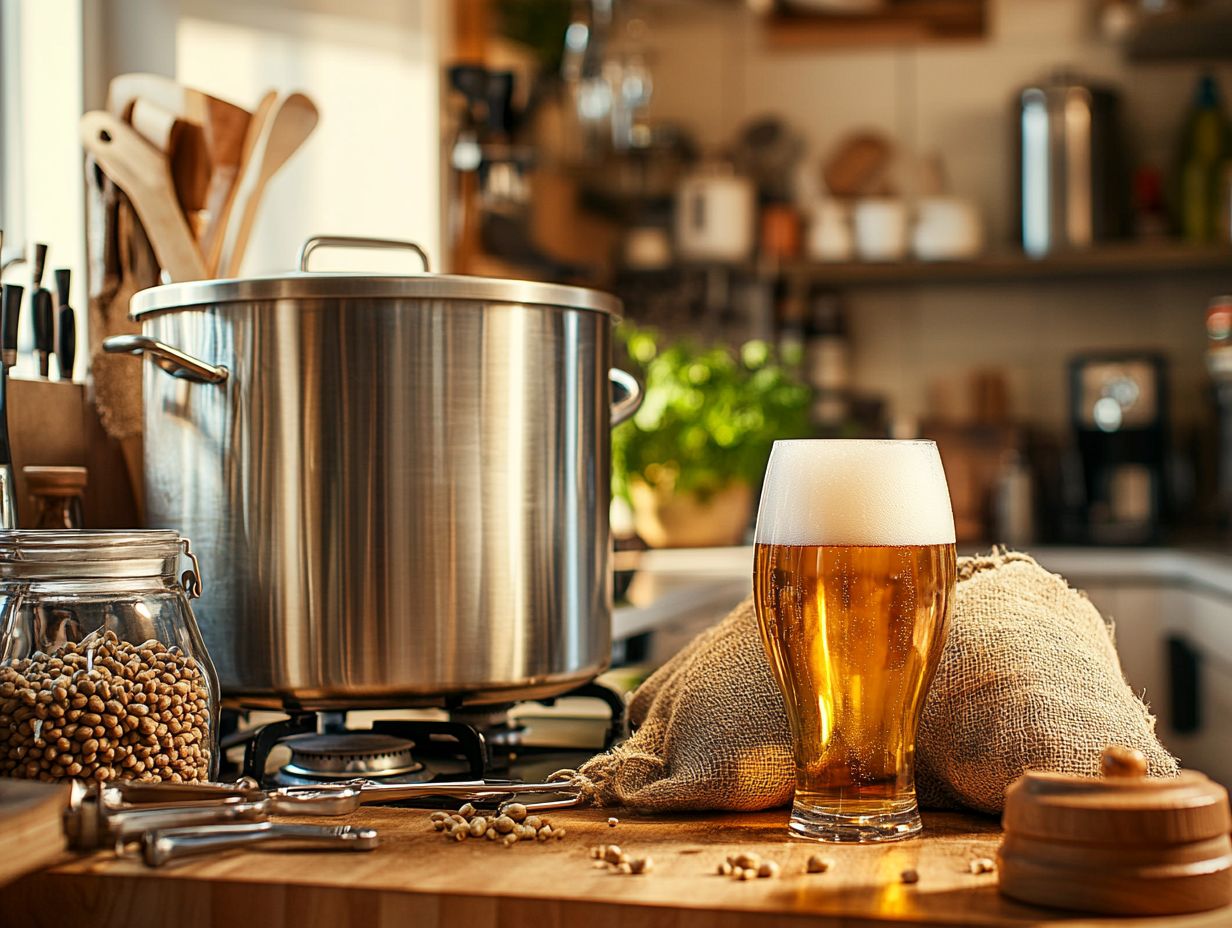
Avoiding common mistakes in home brewing is essential for achieving the quality and success you desire in your beer. Even minor oversights can lead to disappointing results. Proper education on homebrew practices can help minimize errors.
Among the key pitfalls to watch out for is the failure to properly sanitize your equipment, which can introduce unwanted bacteria into your brew. Using low-quality ingredients can significantly detract from the flavor and aroma, compromising the entire experience. Sourcing high-quality malts, hops, and yeast is vital.
1. Not Sanitizing Properly
Neglecting to properly sanitize your equipment can ruin your hard work and lead to contamination. This oversight can easily lead to spoilage of your beer.
Ensuring that all your brewing equipment is thoroughly cleaned and sanitized before each use is fundamental to maintaining the integrity of your brewing process. Contaminants like wild yeast, bacteria, and mold can wreak havoc on your batch, imparting off-flavors and aromas that can turn what could have been a delightful brew into a disappointing disaster.
For instance, Brettanomyces, a wild yeast, can introduce an unwanted funkiness, while Lactobacillus can infuse a sour taste that s often undesirable in many beer styles. To combat these potential pitfalls, you should adopt best practices for sanitization.
This includes using food-safe sanitizers like Star San or iodophor. It s essential to soak all your equipment fermenters, bottles, and even brew kettles for the recommended duration to ensure a complete kill of unwanted microorganisms.
By prioritizing proper sanitation, you can significantly enhance the quality and flavor profile of the beverages you craft. This attention to detail can lead to more drinkable beer and fewer brewing challenges.
2. Over or Under Carbonation
Achieving the perfect level of carbonation is essential for elevating your drinking experience. Too much carbonation can lead to excessive foaming, making your beer a frothy mess, while too little results in a flat, uninspiring brew.
It s vital to accurately measure the priming sugar the sugar added before bottling to create carbonation during bottling to hit that sweet spot for carbonation. This is especially important when kegging beer.
Balancing carbonation levels not only enhances the aroma and mouthfeel but also plays a significant role in shaping the overall flavor profile of your beer. High carbonation can overshadow the delicate nuances of your brew, while insufficient carbonation can rob it of that refreshing quality, leaving you feeling disappointed after each sip.
For home brewers like yourself, be aware of common pitfalls, such as miscalculating the amount of sugar needed or skimping on the fermentation time. A priming calculator can be your best friend in ensuring you add just the right amount. Also, be mindful of wort boiling to eliminate unwanted organisms.
To achieve optimal results, pay close attention to temperature fluctuations in your environment during the conditioning phase. Warmer temperatures tend to enhance carbonation, while cooler settings might slow things down. Being mindful of these factors will undoubtedly elevate the quality of your home brewing endeavors.
Always ensure the fermentation process is properly monitored for best results.
3. Using Low-Quality Ingredients
Don t settle for mediocrity! Using low-quality ingredients in your home brewing can severely compromise the flavor and overall quality of your finished product, leaving you with disappointing results. It’s vital to prioritize sourcing high-quality malts, hops, and yeast as these are crucial in crafting exceptional beer recipes that truly stand out.
Consider using single malt or specialty grains to enhance your brew. Your brewing journey begins with the selection of superior ingredients, which significantly influence the final taste and aroma of your beer.
When you opt for low-quality materials, you may find yourself with an unbalanced flavor profile that overshadows all the hard work you’ve put into the brewing process. To enhance your home brewing experience, seek out ingredients from reputable suppliers, like local brew shops or online retailers renowned for their guarantee of quality.
Engaging with communities of experienced home brewers can offer invaluable insights into sourcing the best components for perfecting your unique recipes. Exploring brewing history can provide a deeper understanding of traditional methods and ingredients.
Resources for Home Brewing
Homebrew education is key for anyone looking to refine their skills and knowledge. As an aspiring home brewer, you’ll find a wealth of resources at your fingertips, offering invaluable insights into brewing techniques, diverse recipes, and the vibrant brewing community.
Explore incredible brewing kits that are bursting with potential! From comprehensive brewing kits that come equipped with everything you need to get started to online forums and websites brimming with expert advice and a myriad of beer recipes, these resources are critical for anyone eager to enhance their brewing knowledge and skills.
Exploring brewing kits from suppliers like Northern Brewer can be particularly beneficial.
Start your brewing adventure today!
Frequently Asked Questions
What equipment do I need to brew my favorite beer at home?
Essential brewing equipment includes:
- A brew kettle
- A fermenter
- An air lock
- Bottles
- A mash tun (optional)
- A wort chiller (optional)
To brew your favorite beer at home, you will need a large stockpot, a fermenting vessel, a siphon, a thermometer, bottles or kegs, and cleaning supplies. You can also invest in brewing equipment like a homebrew kit, which typically includes all the necessary items. Additionally, using bottled spring water can improve the quality of your brew.
Can I use regular kitchen supplies for home brewing?
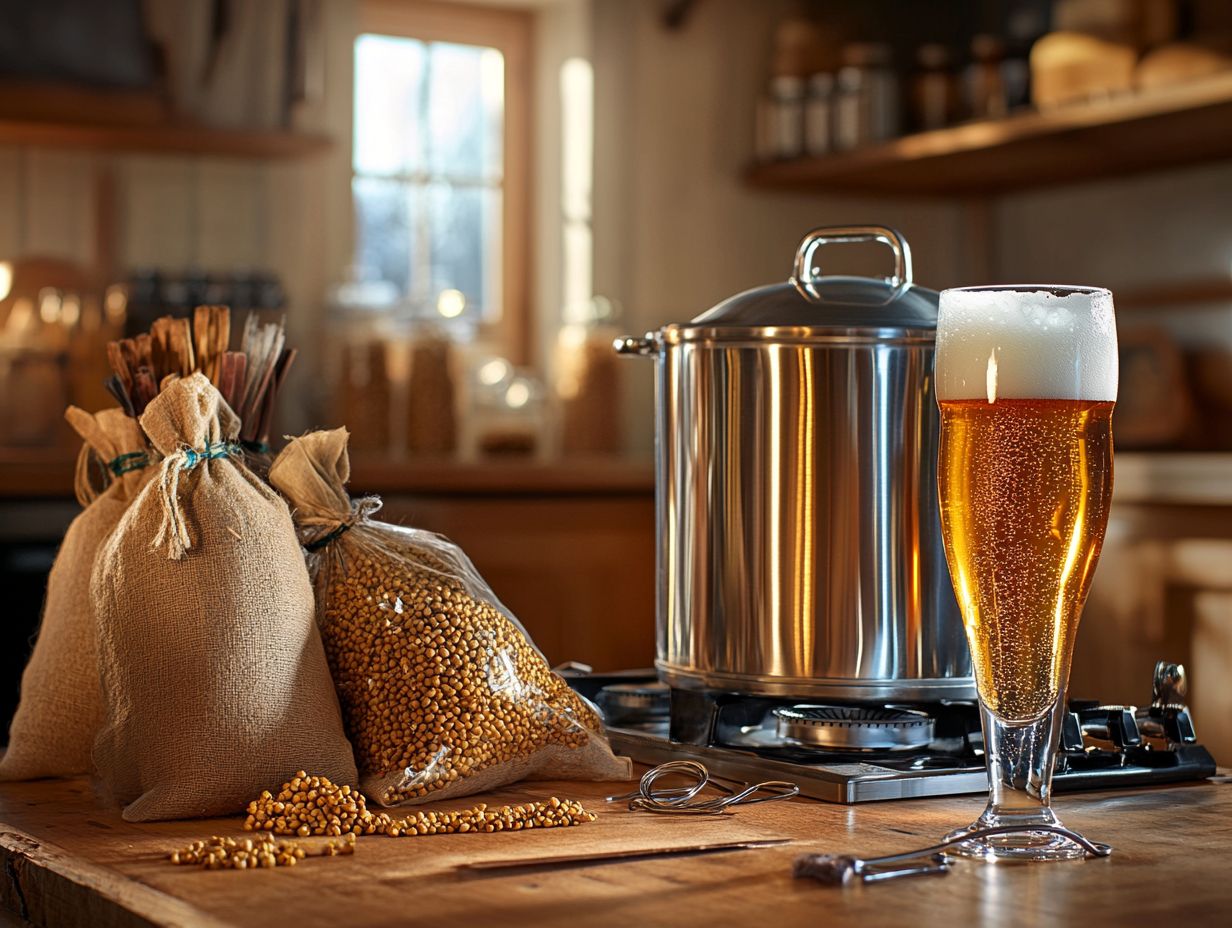
Yes, you can use regular kitchen supplies for home brewing, such as a stockpot and thermometer. However, it is important to ensure that all equipment is thoroughly cleaned and sanitized with products like Star San before use to prevent contamination of your beer.
How do I choose the right ingredients for my homebrew?
When choosing ingredients for your homebrew, consider the style of beer you want to make. Each beer style requires specific malts, hops, yeast, and water.
You can experiment with different combinations of ingredients, such as unique hops and Pilsen malt, to create your own unique flavor. For those interested in extract brewing, using an extract recipe can simplify the process.
Do I need to follow a specific recipe for home brewing?
No, you do not need to follow a specific recipe for home brewing.
It s best for beginners to start with a reliable beer recipe to make a successful batch. Once you gain more experience, you can adjust and create your own recipes while exploring various brewing techniques.
How long does it take to brew my favorite beer at home?
The time it takes to brew your favorite beer at home can vary depending on the recipe and brewing method.
Generally, it takes 3-4 weeks from start to finish, including fermentation and bottling or kegging. Keep the fermentation temperature right for the best results.
Can I store my homebrew for later consumption?
Absolutely! You can enjoy your homebrew later.
Properly bottled or kegged beer can last several months to a year, depending on the style. It is important to store it in a cool, dark place, away from any sources of heat or light.
Remember to practice tasting your beer periodically to ensure it maintains its quality.

